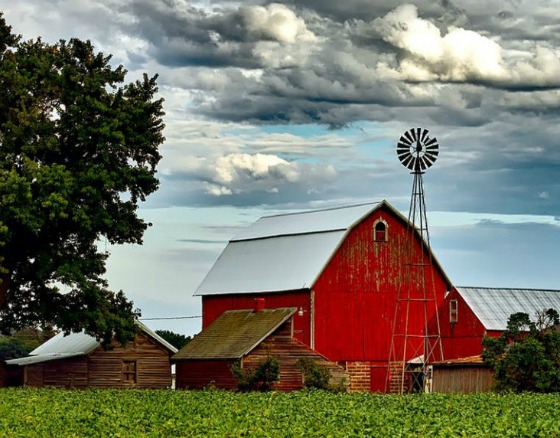This article was originally published by Daisy Luther at The Organic Prepper

Lots of preppers are convinced that they’re going to “live off the land” should the world as we know it come tumbling down around our ears. Seed banks are stockpiled, books are purchased, and people are confident that they’ll be able to outlive everyone else based on the sweat of their inexperienced brows.
But this may not be the best of ideas for some folks.
If you’ve been at it for a while, having a homestead can be a wonderful survival plan and a rewarding lifestyle. But if you think you’re going to go straight from the city to live off the land, you’re in for a horrible – and potentially fatal – surprise.
A prepper homestead is something that must be built over a period of time – it’s absolutely not a plug-and-play solution, regardless of the number of survival seed packets you have carefully stashed away. Homesteading for survival is not a good plan if you have never done it before. No matter how hardworking you are, homesteading takes time. Time for learning, time for mistakes, and time for your plans to come to fruition.
When you do eat a meal in which all the ingredients were produced by you, on your own land, it will be the most delicious, gratifying meal you’ve ever eaten. But it’s a long road to get there.
A prepper homestead isn’t as easy as you may think.
If a prepper homestead is your survival plan, let me give you some advice: STORE. FOOD.
You are going to have to have something to get you through that first year when your farm doesn’t produce diddly squat.
As anyone who has followed this blog for a while knows, my family is prone to new adventures. We’ve moved from a large city to a cabin in the North Woods, where I discovered I knew nothing about building fires and living in the wilderness. We drove across the continent to move from Ontario, Canada, to the West Coast, where I had to rebuild my preps from the ground up since US Customs would not allow us to bring our food supplies across.
Another year, our adventure was food production. My daughter and I moved to a small farm, eager to polish up a new skill set and build that idealized prepper homestead that many of us dream about.
After only a few months there, I realized it was my duty to announce that while raising your own food is a noble goal, it’s not as easy as people seem to think. It was way harder and more time-consuming than I expected.
Of course, shortcuts do exist to help you circumvent all of these issues. If you have lots of money, you can shorten the amount of time it takes for your farm to be productive. The shortcuts all seem to cost a lot more money than the hard-work-method, and if you’re getting into self-reliance on a dime, they may not be practical or affordable. The other issue is, you may not even know the issue exists until it smacks you in the face and you’re chasing a goat down the road in your pajamas, frantically waving your arms to warn approaching pickup trucks to slow down so they don’t mow down your livestock. (Ask me how I know this.)
The real truth is, raising your own food takes time, experience, and skill. It isn’t something you undertake after the SHTF. If a self-reliant homestead is your survival strategy, you need to start now.
The garden
Unless you’re Jack, the possessor of magic beans that grow to prolific heights overnight, you’re going to get awfully hungry waiting for your garden to feed you. The first year a garden is grown in a new place, you learn about all sorts of foibles of your location, things you’d never know unless you have taken the effort to create your own salad bar.
Some folks get lucky and end up with a lush green jungle from the very first season, but for most of us…well, let’s just say that my daughter and I would struggle to live for a week on the calories produced by that first year’s garden.
We had all of the plagues this year that condemned us to gardening failure. First, we moved late in the season, but I had nurtured my veggies in buckets, so I assumed I’d transplant them and they’d magically grow.
Alas, on the first night, they fattened up the local deer. If I shot a deer that got fed by my vegetable plants, would that count towards the success of my gardening efforts? Because that would substantially up the caloric bounty.
So, I re-fenced, got a big dog, and replanted. Then, like something out of a sci-fi movie, freaking GOPHERS yanked the plants down by the roots and made them vanish. All that remained was a fluttering leaf here and there.
I dug out my raised beds, laid hardware cloth at the bottom, and refilled them. Then I replanted again. By this time, it was late July and we had a heatwave. Many of the new plants didn’t survive the blazing 110 degree days, despite shadecloth and plentiful water. Some of the ones that did survive got peed on by the dog I got to protect them from the deer and immediately withered from being drenched in urine.
Did I mention hornworms? They decimated several of my tomatoes and peppers overnight. OVERNIGHT! I watered in the evening and things looked great. The next morning, half of my plants looked as though they’d been scalped. Out of a sense of vengeance, I threw those hornworms in the chicken run to be pecked, tortured, and eaten alive. Take that, you evil little jerks.
That year, all I got was tomatoes and peppers from the plants I saved. Thankfully, we’re big fans of salsa and marinara, but we did not have enough to live off. In four months on my little prepper homestead, I basically produced a large salad.
This is all part of the game, though.
Next year was better because I put into place what I’ve learned. I got a deer-proof fence, I gopher-proofed my raised beds, I figured out how to keep my dog out of the lower beds by placing barriers at the corners after he peed on my favorite tomato plant. Once I harvested the last tomato, I got a cover crop ready to go into the beds to enrich the soil and feed my chickens over the winter. And to greater express my determination, I enrolled in a master gardener’s course through my county extension office, where I learned a lot that was specific to my area and climate.
I did successfully grow food the second year. But not enough to feed us for an entire year. And if we’d had to live off of that first year’s harvest, we’d have died of starvation in a month or so.
Also, those seed banks you’ve stashed away? They’re probably not going to feed your family on a long-term basis. Here’s what a lifelong farmer had to say about them.
Shortcuts:
As I mentioned above, shortcuts are expensive and all of these may not be realistic or fall within your budget.
- Start out protecting your garden from all possible foragers by building a deer-proof, gopher-proof area before you ever plant a seed.
- Test your soil and amend it with stuff from the nursery to provide the perfect growing medium for your veggies. (Add these kits to your stockpile so that you can test your soil regularly throughout the season.)
Take a class from locals, geared towards your environment. - Install a drip irrigation system.
- Pay a master gardener to help you get your garden established.
- The best (and most expensive) shortcut? Move to a place with existing fruit trees, established gardens, and permaculture fixtures.
The eggs
Which came first, the chicken or the egg?
In farming, it’s the chicken. The chickens come well, well, before the eggs. Like, at least 6 months before.
There’s a lot more to backyard egg production than throwing some feed into a henhouse or opening the door to let your birds free-range and telling them to be sure and deposit their eggs neatly in the bins provided to them.
First, many people start with little baby chicks. Not only are they flippin’ adorable, but they’re way cheaper than adult birds. You get to know exactly what they’ve eaten for their entire lives, which means you know whether they’ve been consuming antibiotics or hormones, and can alter their diets to fit your personal food philosophies.
But chicks are fragile. Out of my first batch of 8, five died. FIVE. More than 50%. I felt like an unwilling serial killer of baby animals. Since my subsequent batches have flourished with the exact same care, I suspect there was some illness from the feed store where I purchased them. Baby chicks need special food, an environment that is safe from predators, and a heat source so that they can maintain the right body temperature. Of course, you have to be careful with the heat lamp or you can set your coop on fire, something that very nearly happened to me, but mercifully, we caught it just in time.
When they get big enough, you have to teach them where the water is and put them in a safe place where they won’t be eaten by predators. We have raised chickens in a large covered run that keeps them protected while allowing them fresh air and some freedom and we have free-ranged them. Free-ranging is less work and costs a bit less, but it has more risk. Free range hens often enjoy laying eggs in places other than their nesting boxes, too.
Keep in mind that when it’s too cold or too hot, your chickens won’t lay eggs. If there is a predator sniffing around the coop at night, they won’t lay eggs. When they molt, they will lay fewer eggs. Hens of laying age are actually no guarantee of fresh eggs on a daily basis.
Shortcuts
- Have a predator-proof coop built for you by someone who has raised chickens. You’ll need a floor that nothing can dig under, good door latches, a sturdy top, shade, nesting boxes, and roosts.
- Install an automatic waterer that refills when it gets too low.
- Buy full-grown, already laying chickens.
The milk
Everyone thinks of cows when they think of milk. A calm, productive dairy cow is a wonderful thing. However, this is not an instant kind of thing either. If you get a calf, you should know that cows should not be bred before 15 months, and may not reach maturity until they are 22 months of age. Cow gestation is 9 months, like humans. So you’re looking at about two and a half years or more before you can get so much as a drop of milk from a cow that you bought as a calf. Their poop is enormous, smelly, and draws flies, which is a problem if you don’t have a lot of land for them to roam on. Cows are also quite expensive to purchase and they eat way more than goats, so for the homesteader on a budget, goats are a better option.
Goats come with their own set of difficulties. If you go and get a couple of female baby goats with the intention of bottle feeding them to make them friendly, that’s awesome. You will succeed in having the sweetest goats around, and they’ll follow you around the homestead like a dog. What they won’t do is give you milk for at least a year and a half. 18 months of feeding for them, caring for them, shoveling their poop, and cleaning their stalls.
You should not breed a goat until she’s a year old. Then, if the breeding takes, you have 5 months of waiting for babies. Then, you have a couple of weeks where she’s producing colostrum for her kids, which you should never, ever take. Finally, you have milk. FINALLY. And it’s delicious. But that first glass is the most long-awaited glass of milk you will ever sip.
Goats are cute but can be a total pain in the rear. If you give them a cardboard box full of veggie scraps, they’ll eat the box and ignore the vegetables. They will climb on your vehicle and dent it with their little hooves of destruction. If you fence them in, they will get through, around, or over your fence. No matter how many acres you give them to romp on, whatever is on the opposite side of the fence is what they must have.
Our 10-month-old goat discovered that she fit through our gate and we had to chase her down the road that led to our farm one day. In pajamas, since it was morning and we weren’t dressed yet. We ran hardware cloth through the bars on the gate and that kept her in. At least at that exit point. There’s a project every day with goats. Here’s some GREAT information on housing your goats that I wish I’d seen at the beginning.
Shortcuts
- Fence your grazing area with goat-proof fencing. Once you’ve had goats, you will know that they can jump over, climb through, open the gate, or knock down just about anything you put up.
- Buy cows or goats that are already producing milk. You’ll need more than one mama animal because a) goats and cows are herd animals and b) you can give one mama a break while the other is producing.
- Plant hay. If you have enough space you can greatly reduce your food bill this way.
The meat
Meat is also far from instant. The closest thing to instant meat is going to be rabbits. Cute, fluffy rabbits. They breed quickly and prolifically and are mature by the age of 8-12 weeks, at which time they can be butchered for food. Below, you can see the ages at which these animals can be butchered for meat:
- Chickens 16-20 weeks
- Ducks 24-28 weeks
- Turkeys 24-28 weeks
- Rabbits 8 weeks
- Lambs 10-15 months
- Goats 12 months
- Pigs 8-10 months
- Cows 18-24 months
Of course, this is the age of maturity in the best of all possible worlds. The world that contains premium feed, the ability to pick it up from the feed store, and a controlled environment safe from predators. If your animals are free-ranging, they’re going to grow more slowly and be leaner since they’re working for their food. If you have selected heritage breeds, they grow more slowly still than the hybrids that are bred specifically for a speedy maturity. As you can see, this isn’t an instant gratification kind of thing. Add an SHTF long-term disaster to the mix, and you’re looking at quite some time before you can harvest meat.
It gets even trickier when you want to develop a breeding program on your farm in order to raise your meat. Then, you must add in the time for the mother animal to become mature, waiting for the right time to breed her, and then waiting for the gestation period to be over. Literally, we’re talking about years before you have meat production for many species.
Then there’s the butchering. Are you going to be able to slaughter the animal you saw born, raised from a little baby, and perhaps gave a clever name to? Lots of people are fine with this, but many others will find that it’s much harder than they expected. Humanely dispatching an animal takes experience and the right tools. Cleaning and butchering the animal is also not something you can dive right into. If you’re lucky, you’ll have some farmer friends who will help you the first time or two. It’s an enormous job and you run the very real risk of spoiling your meat if you don’t know what you’re doing.
Shortcuts
- Buy animals that are just past the fragile stage and raise them to maturity
- Stock up on a whole full of pellet food and hay for your livestock
- Have your property professionally fenced.
- Buy a property that is fenced and contains housing for various types of livestock
- Get to know local farmers and learn all you can from them. They can help you prevent expensive mistakes.
Reality check: You’re probably going to fail
So, you might read this article and think I’m telling you that a prepper homestead is an unrealistic survival plan. That’s not the case at all.
What I’m telling you is that a prepper homestead has to be created well before a disaster strikes. You have to figure out:
- How you’ll care for your crops and animals.
- How you’ll nourish them.
- How you’ll protect them.
- How you’ll water them.
- How you’ll harvest the food.
And honestly, you’ll probably fail to do one or all of these things correctly at some point.
You have to learn many of these things from experience. My experience can’t teach you because my setting is entirely different. You may have different predators, a different climate, different physical challenges – every single family’s circumstances will be unique. The only way to predict the problems and overcome them is to experience them in the first place. And trust me, it’s way better to experience failure when the feed store and the hardware store are only a short drive away.
Be sure to have back-up plans.
While it’s incredibly important to take every step you can towards self-reliance, it is equally vital to have a backup plan. Have these things to fall back on:
- A good reference – my very favorite go-to book is my well-used copy of The Encyclopedia of Country Living. But, remember, reading books is no substitute for experience and cold, hard failure.
- A food storage pantry –
- Long-term storable food – THIS is my very favorite brand. It’s non-GMO and has gluten-free options.
- Extra seeds – go for heirloom, non-GMO packets and store them carefully.
- Preparedness supplies that aren’t reliant on your farming efforts – learn to create a preparedness plan HERE.
- Supplies and instructions to preserve your harvest – check out my canning book HERE.
Share your own homesteading lessons
Most of us learn our homesteading lessons through failure. Something we thought would work, did not. Are you raising your own food? What did you learn the hard way? Please share your experiences from your prepper homestead in the comments below.
Please feel free to share any information from this article in part or in full, giving credit to the author and including a link to The Organic Prepper and the following bio.
Daisy is a coffee-swigging, gun-toting, homeschooling blogger who writes about current events, preparedness, frugality, and the pursuit of liberty on her websites, The Organic Prepper and DaisyLuther.com She is the author of 4 books and the co-founder of Preppers University, where she teaches intensive preparedness courses in a live online classroom setting. You can follow her on Facebook, Pinterest, and Twitter,.











0 Comments